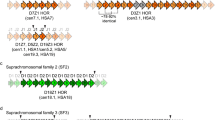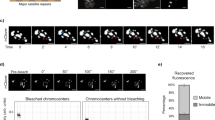Abstract
Elevated levels of extrachromosomal circular DNA (eccDNA or spcDNA) are closely associated with genomic instability and aging. Despite extensive studies, the mechanism of its generation in mammalian cells is unknown. We report here that mouse major satellite DNA (MSD) is prone to eccDNA formation and that the resulting molecules are multimeres of the basic repeat. Extrachromosomal circular major satellite (ECMS) DNA constitutes the majority of eccDNA in B16 mouse melanoma cells and is highly abundant in other mouse cells. Production of these molecules is enhanced in proliferating cells, suggesting that processes associated with DNA replication are involved in their appearance. Using siRNA technique we show that DNA Ligase IV is engaged in ECMS synthesis. Based on our findings we propose a novel two-step model for eccDNA formation in mammalian cells.







Similar content being viewed by others
References
Assum G, Fink T, Steinbeiber T, Fisel KJ . (1993). Hum Genet 91: 489–495.
Autiero M, Camarca A, Ciullo M, Debily A, El Marhomy S, Pasquinelli R et al. (2002). Int J Cancer 99: 370–377.
Bertelsen AH, Humayun MZ, Karfopoulos SG, Rush MG . (1982). Biochemistry 21: 2076–2085.
Brummelkamp TR, Bernards R, Agami R . (2002). Science 296: 550–553.
Cesare AJ, Griffith JD . (2004). Mol Cell Biol 24: 9948–9957.
Chatterjee B, Lo CW . (1989). J Mol Biol 210: 303–312.
Cohen S, Lavi S . (1996). Mol Cell Biol 16: 2002–2014.
Cohen S, Mechali M . (2001). Nucleic Acids Res 29: 2542–2548.
Cohen S, Menut S, Mechali M . (1999). Mol Cell Biol 19: 6682–6689.
Cohen S, Regev A, Lavi S . (1997). Oncogene 14: 977–985.
Cohen S, Yacobi K, Segal D . (2003). Genome Res 13: 1133–1145.
Degroote F, Pont G, Picard G . (1989). Chromosoma 89: 201–206.
Ferguson DO, Alt FW . (2001). Oncogene 20: 5572–5579.
Gaubatz JW, Flores SC . (1990). Mutat Res 237: 29–36.
Gaubatz JW . (1990). Mutat Res 237: 271–292.
Henson JD, Neumann AA, Yeager TR, Reddel RR . (2002). Oncogene 21: 598–610.
Hirt B . (1967). J Mol Biol 26: 365–369.
Kiyama R, Matsui H, Okumura K, Oishi M . (1987). J Mol Biol 193: 591–597.
Kunisada T, Yamagishi H, Ogita ZI, Kirakawa T, Mitsui Y . (1985). Mech Ageing Dev 29: 89–99.
Lewis JD, Meehan RR, Henzel WJ, Maurer-Fogy I, Jeppesen P, Klein F et al. (1992). Cell 69: 905–914.
Motejlek K, Schindler D, Assum G, Krone W . (1993). Mutat Res 293: 205–214.
Nehls M, Boehm T . (1995). Trends Genet 11: 39.
Ohki R, Oishi M, Kiyama R . (1995). Nucleic Acids Res 23: 4971–4977.
Park PU, Defossez PA, Guarente L . (1999). Mol Cell Biol 19: 3848–3856.
Pont G, Degroote F, Picard G . (1988). Nucleic Acids Res 16: 8817–8833.
Regev A, Cohen S, Cohen E, Bar-Am I, Lavi S . (1998). Oncogene 17: 3455–3461.
Sambrook J, Fritsch EF, Maniatis T . (1989). Molecular Cloning: A Laboratory Manual. 2nd ed. Cold Spring Harbor Laboratory Press: Cold Spring Harbor, NY.
Selig S, Ariel M, Goitein R, Marcus M, Cedar H . (1988). EMBO J 7: 419–426.
Silver LM . (1995). Mouse Genetics: Concepts and Applications. Oxford University Press: Oxford, UK.
Sinclair DA, Guarente L . (1997). Cell 91: 1033–1042.
Takeuchi Y, Horiuchi T, Kobayashi T . (2003). Genes Dev 17: 1497–1506.
Van Loon N, Miller D, Murnane JP . (1994). Nucleic Acids Res 13: 2447–2452.
Wang RC, Smogorzewska A, de Lange T . (2004). Cell 119: 355–368.
Zhong Q, Boyer TG, Chen PL, Lee WH . (2002). Cancer Res 62: 3966–3970.
Acknowledgements
We thank Dana Sherill-Rofe for advice and discussions and Dr Daniella Ben-Meir and Boris Slobodin for technical assistance and discussions.
This research was funded by the Israel Cancer Association through the estate of the late Ethel Cohen and the Israel Cancer Research Fund (ICRF).
Author information
Authors and Affiliations
Corresponding author
Rights and permissions
About this article
Cite this article
Cohen, Z., Bacharach, E. & Lavi, S. Mouse major satellite DNA is prone to eccDNA formation via DNA Ligase IV-dependent pathway. Oncogene 25, 4515–4524 (2006). https://doi.org/10.1038/sj.onc.1209485
Received:
Revised:
Accepted:
Published:
Issue Date:
DOI: https://doi.org/10.1038/sj.onc.1209485
- Springer Nature Limited
Keywords
This article is cited by
-
Molecular characterization of cell-free eccDNAs in human plasma
Scientific Reports (2017)
-
Lithium promotes DNA stability and survival of ischemic retinal neurocytes by upregulating DNA ligase IV
Cell Death & Disease (2016)
-
Interstitial telomeric repeats are enriched in the centromeres of chromosomes in Solanum species
Chromosome Research (2013)
-
Survey of extrachromosomal circular DNA derived from plant satellite repeats
BMC Plant Biology (2008)
-
H3K9 methylation and RNA interference regulate nucleolar organization and repeated DNA stability
Nature Cell Biology (2007)




